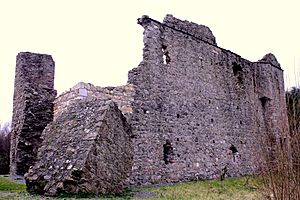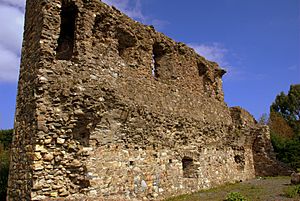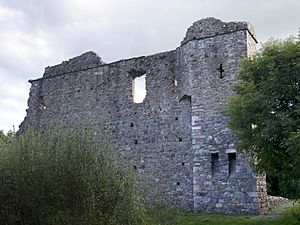Kindlestown Castle facts for kids
Quick facts for kids Kindlestown Castle |
|
|---|---|
| Native name Irish: Caisleán Bhaile an Chinligh |
|
 |
|
| Type | Castle (hall house) |
| Location | Kindlestown, Delgany, County Wicklow, Ireland |
| Built | late 13th century |
| Official name: Kindlestown Castle | |
| Reference no. | 323 |
| Lua error in Module:Location_map at line 420: attempt to index field 'wikibase' (a nil value). | |
Kindlestown Castle is an old castle and a special historic site called a National Monument in Delgany, Ireland. It's a cool example of a "hall house" from long ago.
Contents
Where is Kindlestown Castle?
Kindlestown Castle is found on the side of Kindlestown Hill. It's just north of a town called Delgany. The castle is about 1.9 kilometers (1.2 miles) west of Greystones railway station. It's also close to a modern housing area called Dromont.
The History of Kindlestown Castle
Kindlestown Castle was built a long time ago, in the late 1200s. It's a type of castle known as a "hall house." This means it was mainly one large building, not a huge complex with many towers. From its spot, the castle had a great view of the countryside and the Irish Sea.
Who Built the Castle?
The castle gets its name from a person named Albert de Kenley. He was a very important official, the Sheriff of Kildare, around the year 1301. Many people believe he built the castle. However, some think it might be even older, from around 1225, and was built by someone named Walter de Bendeville.
Protecting the Land
In 1292, Albert de Kenley married Joan. She was the widow of a knight named Ralph Mac Giolla Mocholmág. Albert then looked after Joan's son's lands. He kept some of the land for himself. He might have built Kindlestown Castle to protect these lands from attacks by local Irish families.
Around 1301, a group called the Uí Broin (O'Byrnes) burned down a nearby castle called Rathdown Castle. The people from Rathdown might have gone to Kindlestown Castle for safety. However, Joan's son, John Fitzdermot, didn't want to fight the O'Byrnes. So, around 1305, he gave the Rathdown area to Nigel le Brun, another important official.
Battles and New Owners
In 1377, the Uí Broin family managed to take Kindlestown Castle itself. But it was later taken back by Robert Wikeford, who was a very high-ranking judge in Ireland. After that, the castle became the property of the Archbold family.
Around 1402, the O'Byrnes tried to take the castle again. But Donnacha O'Byrne was defeated by the Archbolds. Kindlestown Castle did well during this time. Records from 1621 show that it was surrounded by about 400 acres (162 hectares) of land. It also had a water mill, which was used to grind grain.
Eventually, the Archbold family got into financial trouble. In 1630, Edward Archbold sold Kindlestown Castle to William Brabazon, 1st Earl of Meath.
What the Castle Looks Like
The castle, or "hall house," is about 21 meters (69 feet) long and 9.8 meters (32 feet) wide. It stands about 8 meters (26 feet) tall. Its walls are very thick, about 1.5 meters (5 feet) wide!
Surviving Parts
The northern wall and part of the eastern wall are still standing. They reach up to the top, where the "parapet" would have been. A parapet is a low wall along the edge of a roof or balcony. Sadly, the southern and western walls were taken down after the medieval period.
The castle that remains has two floors. It's built from rough limestone. Some cool features include a small tower that sticks out from the north-west corner. Inside, on the ground floor, there's an original "barrel vault." This is a ceiling shaped like a half-cylinder. The main entrance is also on the ground floor, in the eastern wall. There's also a staircase built into the wall itself.
Windows and Details
The windows are small and narrow on the outside. These were called "arrowslits" because they were designed for archers to shoot arrows through. On the inside, these windows widen into "embrasure"s, which are arched openings. You can still see window-seats on the first floor. There are also remains of a slanted parapet and a stone "string-course" on the front. A string-course is a horizontal band of stone that sticks out slightly from the wall.



